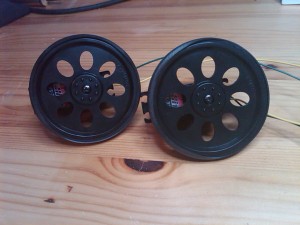Spinning our wheels
We need a way to make the coasterbot move, and without getting too exotic, this means adding some wheels. And some motors to make them turn. The Jameco bundle includes two Hitech HS-322HD servo motors. Once again, this was all new to me, so I did some reading. Servo motors are used to precisely position an output shaft (to which a wheel can be attached). They are very powerful for their size, a useful feature for robots where weight is almost always a concern. They often appear in remote-control devices where precise control of steering is useful.
But. They do not do continuous rotation. There is a mechanical stop built in that will prevent rotation beyond 360 degrees. This is a bit of a problem if we want steady motion in one direction. And the solution is to modify the servomotor.
I have to admit that I was not too thrilled to discover that my motors, ordered as part of a kit made for just this purpose, had to be opened up. Apparently though, these are the best value for the money. I have a pair of DC motors lying around from a beginning robot book project that I never did. I considered using them, but that would have involved making couplers and mounts. Too much work! So on with the servo motor hack.
Fortunately, Karl Demuth did an excellent tutorial on modifying the Hitech HS-322HD. This was extremely helpful and very detailed with lots of photos, so I won’t repeat it here. However, I discovered two things that are worth knowing if you intend to follow those instructions:
- Wear eye protection when snipping off the gear stop. It flies off with a lot of energy, even if you are very gentle.
- Once the long screws are removed in step one, the front plate for the gears is also loosened. It can fall off and gears may scatter. This is likely to happen when the potentiometer is removed. For the second motor I ended up having to open up the first one again so that I could reconstruct gear positions. Karl has a nice photo of them from the top; here is the one I needed, a view from the side.
(Karl — if you see this — I couldn’t post a comment on your blog. Please disable the required login feature, most of us don’t have accounts at the other sites listed.)
This went fairly smoothly. Other than the gear scatter, the only annoyance was using the desoldering pump. I found that it works well, but only if you clean it after each suck. This is done either by sticking a pin in it or (every few times) unscrewing the nozzle to clear it out.
Finally I attached the included wheels, and confirmed that they spin when voltage is applied. They reverse directions when the polarity is switched. Pretty cool.

